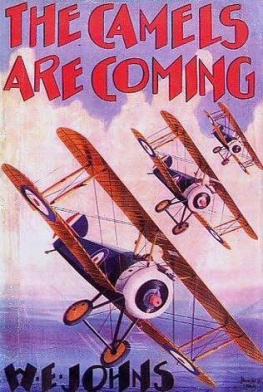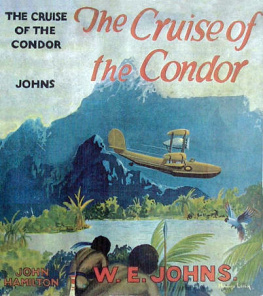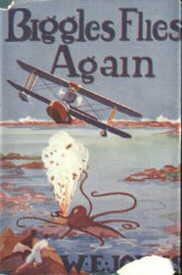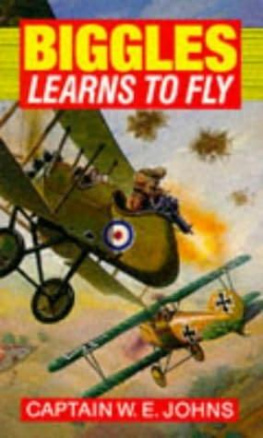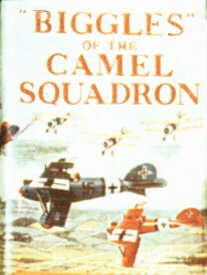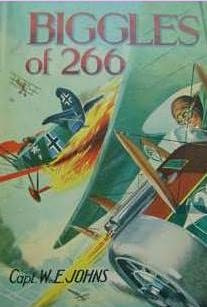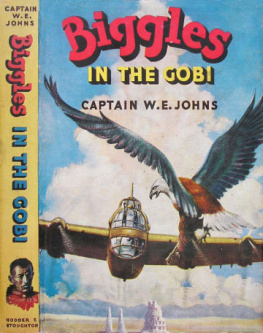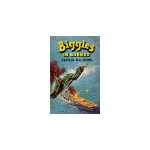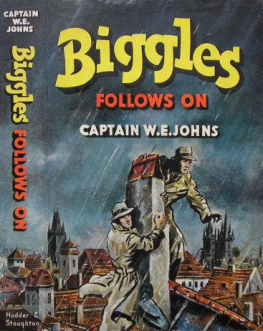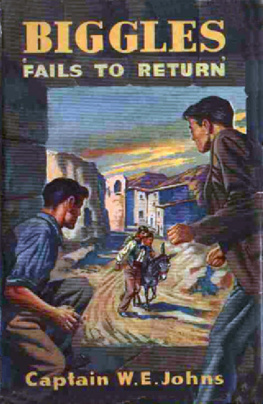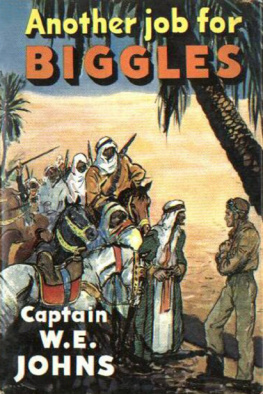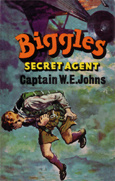W.E. Johns - Biggles: The Camels Are Coming
Here you can read online W.E. Johns - Biggles: The Camels Are Coming full text of the book (entire story) in english for free. Download pdf and epub, get meaning, cover and reviews about this ebook. year: 2003, publisher: Red Fox, genre: Detective and thriller. Description of the work, (preface) as well as reviews are available. Best literature library LitArk.com created for fans of good reading and offers a wide selection of genres:
Romance novel
Science fiction
Adventure
Detective
Science
History
Home and family
Prose
Art
Politics
Computer
Non-fiction
Religion
Business
Children
Humor
Choose a favorite category and find really read worthwhile books. Enjoy immersion in the world of imagination, feel the emotions of the characters or learn something new for yourself, make an fascinating discovery.
- Book:Biggles: The Camels Are Coming
- Author:
- Publisher:Red Fox
- Genre:
- Year:2003
- Rating:5 / 5
- Favourites:Add to favourites
- Your mark:
- 100
- 1
- 2
- 3
- 4
- 5
Biggles: The Camels Are Coming: summary, description and annotation
We offer to read an annotation, description, summary or preface (depends on what the author of the book "Biggles: The Camels Are Coming" wrote himself). If you haven't found the necessary information about the book — write in the comments, we will try to find it.
Biggles: The Camels Are Coming — read online for free the complete book (whole text) full work
Below is the text of the book, divided by pages. System saving the place of the last page read, allows you to conveniently read the book "Biggles: The Camels Are Coming" online for free, without having to search again every time where you left off. Put a bookmark, and you can go to the page where you finished reading at any time.
Font size:
Interval:
Bookmark:
BIGGLES BOOKS PUBUSHED IN THIS EDITION:
Biggles: The Camels are Coming
Biggles in France
Biggles Learns to Fly
Biggles and the Rescue Flight
Biggles Flies East Biggles of the Fighter Squadron
Biggles & Co.
Biggles in Spain
Biggles Defies the Swastika
Biggles Fails to Return Biggles Defends the Desert
Biggles in the Orient Biggles: Spitfire Parade (graphic novel)
Biggles adventures available on cassette from
Tellastory, featuring Tim Pigott-Smith as Biggles:
Biggles Flies East Biggles Defies the Swastika
BIGGLES: THE CAMELS ARE COMING
CAPTAIN W. E. JOHNS
RED FOX
Red Fox would like to express their grateful thanks for help in preparing these editions to Jennifer Schofield,
co-author of Biggles: the life of Captain W. E.Johns published by Veloce Publications, Linda Shaughnessy of A. P. Watt Ltd and especially to John Trendler, editor of
Biggles & Co, the quarterly magazine for Biggles
enthusiasts, the address of which may be found at the
back of the book.
A Red Fox Book
Published by Random House Children's Books 20 Vauxhall Bridge Road, London SW1V 2SA
A division of Random House UK Ltd
London Melbourne Sydney Auckland
Johannesburg and agencies throughout the world
First published by John Hamilton, London
Published as Biggles, Pioneer Air Fighter, Armada
Red Fox edition 1993 3579 10 864 1932 WE Johns
This book is sold subject to the condition that it shall not, by way of trade or otherwise, be lent, resold, hired out, or otherwise circulated without the publisher's prior consent in any form of binding or cover other than that in which it is published and without a similar condition including this condition being imposed on the subsequent purchaser
RANDOM HOUSE UK Limited Reg. No.
Phototypeset by Intype, London Printed and bound in Great Britain by Cox & Wyman Ltd, Reading, Berkshire
ISBN
Contents
Foreword
The White Fokker
The Packet
J-
The Baloonatics
The Blue Devil
Camouflage
The Carrier
Spads and Spandaus
The Zone Call
The Decoy
The Boob
The Battle of Flowers
The Bomber
On Leave
Fog!
Affaire de Coeur
The Last Show
Foreword
Captain James Bigglesworth is a fictitious character, yet he could have been found in any R.F.C.* mess during those great days of 1917 and 1918 when air combat had become the order of the day and air duelling was a fine art. 'Biggles,' as I have said, did not exist under that name, yet he represents the spirit of the R.F.C. daring and deadly when in the air, devil-may-care and debonair when on the ground.
To readers who are unfamiliar with the conditions that prevailed in the blue skies of France during the last two years of the War, it may seem unlikely that so many adventures could have fallen to the lot of one man. In those eventful years, every dayand I might almost say every hourbrought adventure, tragic or humorous, to the man in the air, and as we sat in our cockpits warming up our engines for the dawn 'show**', no one could say what the end of the day would bring, or whether he would be alive to see it.
Again, it may seem improbable that any one man could have been involved in so many hazardous undertakings, and yet survive. That may be true; sooner or later most War pilots met the inevitable fate of the flying fighter. I sometimes wonder how any of us sur-
* Royal Flying Corps 1914-1918. An array corps responsible for military aeronautics, renamed the Royal Air Force (RAF) when amalgamated with the Royal Naval Air Service on 1st April 1918. ** Slang: operational flight into enemy-held territory.
vived, yet there were some who seemed to bear a charmed life. William Bishop, the British ace, Rene Fonck, the French ace and prince of air duellists, and, on the other side, Ernst Udet, and many others, fought hundreds of battles in the air and survived thousands of hours of deadly peril. Every day incredible deeds of heroism were performed by pilots whose names are unknown, and had the Victoria Cross been awarded consistently, hundreds instead of a few would have worn the coveted decoration.
Nowhere are the curious whims of Lady Luck so apparent as in the air. Lothar von Richthofen, brother of the famous ace, shot down forty British machines; he was killed in a simple cross-country flight shortly after the War. Nungesser, the French champion of forty-five air battles, was drowned, and McKeever, Canadian ace of thirty victories, was killed in a skidding motor-car. Captain 'Jock' McKay of my Squadron survived three years air warfare, only to be killed by 'archie*' an hour before the Armistice was signed. Lieutenant A. E. Amey, who fought his first and last fight beside me, had not even unpacked his kit! I have spun into the ground out of control from 6,000 feet, yet I am alive to tell the tale. Gordon, of my Squadron, made a good landing, but bumped on an old road that ran across the aerodrome, turned turtle, and broke his neck.
Again, should the sceptic think I have been guilty of exaggeration, I would say that exaggeration is almost impossible where air combat is concerned. The terrific speed at which a dog-fight took place and the amazing manner in which machines appeared from nowhere, and could disappear, apparently into thin air, was so
* Slang: Anti-aircraft gunfire
bewildering as to baffle description. It is beyond my ability to convey adequately the sensation of being one of ten or a dozen machines, zooming, whirling, and diving among the maze of pencil lines that marked the track of tracer bullets.* One could not exaggerate the stunning horror of seeing two machines collide head-on a few yards away, and words have yet to be coined to express that tightening of the heart-strings that comes of seeing one of your own side roaring down in a sheet of flame. Seldom was any attempt made by spectators to describe these things at the time; they were best forgotten.
It is not surprising that many strange incidents occurred, incidents which were never written down on combat reports, but were whispered 'with wrinkled brows, with nods, and rolling eyes' in dim corners of the hangars while we were waiting for the order to start up or for the 'late birds' to come home to roost. It was 'H', a tall South African S.E.** pilot who came in white-faced and told me that he had just shot down a Camel*** by mistake. It was the Camel pilot's fault. He playfully zoomed over the S.E., apparently out of sheer light-heartedness. 'H' told me that he started shooting when he only saw the shadow; he turned and saw the red, white, and blue circles, but it was too late. He had already gripped the Bowden control and fired a burst of not more than five rounds. He had fired
* Phosphorus-loaded bullets whose course through the air could be seen
by day and by night.
** Scouting experimental single-seater British biplane fighter in service
-
*** Sopwith Camel, a single-seater biplane fighter with twin machine
guns synchronised to fire through the propeller. See front cover for
illustration.
f The 'trigger' to fire the guns, usually fitted to a pilot's control column.
hundreds of rounds at enemy aircraft without hitting one, but the Camel fell in flames. He asked me if he should report it, and I, rightly or wrongly, said no, for nothing could bring the Camel back. 'H' went West* soon afterwards.
What of TL ' still in the Service, who was attacked by a Belgian scout? For ten minutes he endeavoured to escape, and then, exasperated, he turned and shot the Belgian down, narrowly escaping court-martial as a consequence. Almost everybody has heard the story told by Boelcke, the German ace and he was a man to be believed of how he once found a British machine with a dead crew flying a ghostly course amid the clouds. On another occasion he shot down an F.E.** which, spinning viciously, threw its observer out behind the German lines and the pilot behind the British lines. What of the R.E.8*** that landed perfectly behind our lines with pilot and observer stiff and stark in their cockpits! The R.E.8 was not an easy machine to land at any time, as those who flew it will bear witness.
Next pageFont size:
Interval:
Bookmark:
Similar books «Biggles: The Camels Are Coming»
Look at similar books to Biggles: The Camels Are Coming. We have selected literature similar in name and meaning in the hope of providing readers with more options to find new, interesting, not yet read works.
Discussion, reviews of the book Biggles: The Camels Are Coming and just readers' own opinions. Leave your comments, write what you think about the work, its meaning or the main characters. Specify what exactly you liked and what you didn't like, and why you think so.

